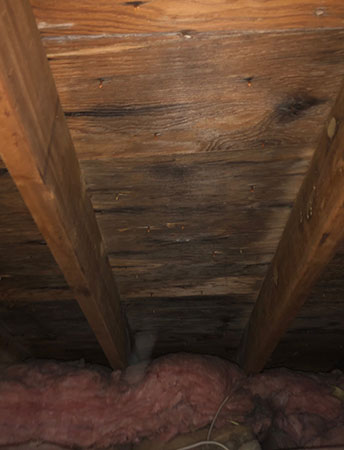How to Eliminate Mold From Every Home Surface
Mold spores are everywhere around us in every kind of climate. Mold is fungi and some types are exceptionally beneficial to humanity (consider penicillin), while others can be quite harmful to crops, respiratory systems, and the stability of structures. Unsafe Mold vs. Mildew The most typical kind of mold found in homes is mildew.
Mildew is a surface area mold that grows in warm, damp places like your bathroom and on fabrics and books kept in wet basements. Mildew begins as a gray or white grainy nest. It will turn black or brown if not removed without delay and often looks like soil build-up. To test if the surface area is covered with mildew or simply dirt, dab the stain with a cotton bud dipped in home chlorine bleach. If the stain lightens or vanishes after 2 or three minutes, it's mildew. If not, it's probably just dirt. If you detect a moldy odor throughout your home, then you have a high concentration of mold. It can be coming from a hamper filled with damp towels, from a wet crawlspace under your home, or carpets that have mold growing in the cushioning. It's definitely time to take action to get rid of the problem. Now you know that all mildew is mold but not all molds are mildew.
Mildew can stain and slowly harm surfaces however there are much more harmful molds that can harm the structure of your home. If you see a black or green mold that is fuzzy or slimy and the drywall or wood below is soft or collapses, there is irreparable rot and the mold and the damaged surface areas need to http://edition.cnn.com/search/?text=Mold inspection be removed immediately.
Working with Specialists If mildew invasion is captured early, you can easily manage it with household cleaners.
Caution For comprehensive mold issues, consider hiring an expert. Some molds are extremely harmful and even less harmful molds can trigger issues for anybody with mold allergic reactions or compromised respiratory systems. The guideline is if the mold covers 10 or more square feet, call in a professional. Removing large mold colonies requires direct exposure to durable chemicals and correct disposal of plagued structure materials.
Local public health departments can provide recommendations on mold screening and refer you to a specialist mold remover.
Products That Kill Mold Chlorine bleach: Sodium hypochlorite or regular household bleach works best to ruin mold and remove any discoloration. It is quite severe and must be diluted before using.
Warning Care ought to be utilized due to toxicity and hazardous fumes and bleach ought to never ever be integrated with ammonia.
Hydrogen peroxide: Less severe than chlorine bleach, hydrogen peroxide (3 to 10 percent service) will kill mold and lighten stains. While it does have a lightening impact, it works more slowly than chlorine bleach however has no toxic fumes or residue.
Distilled white vinegar: Vinegar is acidic and gradually breaks down the structure of mold and kills it. Vinegar is non-toxic however mold discolorations may remain and extra scrubbing with a home cleaner might be required.
Sodium bicarbonate and borax: Salt bicarbonate (baking soda) and borax each have a high pH that hinders the growth and survival of mold. Both items are economical, non-toxic, and simple to blend with water. Borax will work better in getting rid of any sticking around spots but not as effectively as a more powerful cleansing item. When utilizing any of these products, do not wash away the cleansing service totally. Leaving a little bit of the cleaner will help hinder future mold development.
Removal from Fabric If your house has actually been flooded and mold and bacteria have been delegated grow for many days, it might be difficult to salvage material products. Nevertheless, if mildew has actually established due to dampness and is caught early, it can easily be removed from many materials. Begin by taking the products outside to brush away as much surface area mold as possible and to prevent spreading the mold spores inside your home. If the fabric is washable, use the most popular water recommended on the care label and add a disinfectant. If stains remain, produce a solution of oxygen bleach and water and allow the clothing to soak for a minimum of 8 hours.
Oxygen bleach can be utilized safely on any washable fabric. For fabrics that are dry tidy only, brush away the mildew outside https://precision-environmental-services.business.site/posts/107069172425445340 and then head to a professional cleaner. Recognize and mention the stains and a lot of materials can be successfully brought back.
Leather Shoes, Coats, Add-on, and Furnishings Mold on leather coats, shoes, handbags, and furnishings must be gotten rid of outside, if possible. Clean down the surface with a cloth dipped in distilled white vinegar and after that with a good leather soap and warm water. Dry with a soft fabric and permit to air dry totally. When completely dry, deal with the item with a leather conditioner.
Books and Documents Mold will eventually damage paper but it can be effectively gotten rid of. For pricey books and historically significant papers, seek advice from a professional manager. Never try to deal with moist paper. The mold will smear and end up being nearly difficult to remove. Permit the paper in books to air dry completely in the sun or place in a sealed container with moisture absorbent material like silica gel or cornstarch sprayed in between the pages. When the book is dry, head outside and utilize a soft paintbrush or cloth to carefully brush away the mildew from the cover and each page. Slide a sheet of waxed paper under each page to protect the page behind it. Slightly moisten a tidy, soft cloth with hydrogen peroxide and carefully clean down each page permitting it to air dry totally prior to transferring to the next page.
